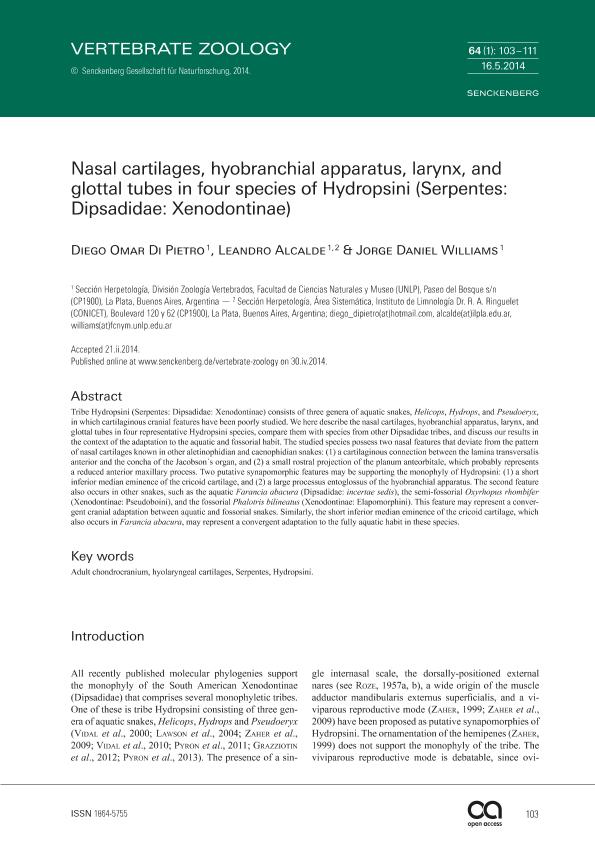Artículo
Nasal cartilages, hyobranchial apparatus, larynx, and glottal tubes in four species of Hydropsini (Serpentes: Dipsadidae: Xenodontinae)
Fecha de publicación:
30/04/2014
Editorial:
Senckenberg Gesellschaft für Naturforschung
Revista:
Vertebrate Zoology
ISSN:
1864-5755
Idioma:
Inglés
Tipo de recurso:
Artículo publicado
Clasificación temática:
Resumen
Tribe Hydropsini (Serpentes: Dipsadidae: Xenodontinae) consists of three genera of aquatic snakes, Helicops, Hydrops, and Pseudoeryx, in which cartilaginous cranial features have been poorly studied. We here describe the nasal cartilages, hyobranchial apparatus, larynx, and glottal tubes in four representative Hydropsini species, compare them with species from other Dipsadidae tribes, and discuss our results in the context of the adaptation to the aquatic and fossorial habit. The studied species possess two nasal features that deviate from the pattern of nasal cartilages known in other aletinophidian and caenophidian snakes: (1) a cartilaginous connection between the lamina transversalis anterior and the concha of the Jacobson´s organ, and (2) a small rostral projection of the planum anteorbitale, which probably represents a reduced anterior maxillary process. Two putative synapomorphic features may be supporting the monophyly of Hydropsini: (1) a short inferior median eminence of the cricoid cartilage, and (2) a large processus entoglossus of the hyobranchial apparatus. The second feature also occurs in other snakes, such as the aquatic Farancia abacura (Dipsadidae: incertae sedis), the semi-fossorial Oxyrhopus rhombifer (Xenodontinae: Pseudoboini), and the fossorial Phalotris bilineatus (Xenodontinae: Elapomorphini). This feature may represent a convergent cranial adaptation between aquatic and fossorial snakes. Similarly, the short inferior median eminence of the cricoid cartilage, which also occurs in Farancia abacura, may represent a convergent adaptation to the fully aquatic habit in these species.
Palabras clave:
Adult Chondrocranium
,
Hyolaringeal Cartilages
,
Serpentes
,
Hydropsini
Archivos asociados
Licencia
Identificadores
Colecciones
Articulos(ILPLA)
Articulos de INST.DE LIMNOLOGIA "DR. RAUL A. RINGUELET"
Articulos de INST.DE LIMNOLOGIA "DR. RAUL A. RINGUELET"
Citación
Di Pietro, Diego Omar; Alcalde, Leandro; Williams, Jorge Daniel; Nasal cartilages, hyobranchial apparatus, larynx, and glottal tubes in four species of Hydropsini (Serpentes: Dipsadidae: Xenodontinae); Senckenberg Gesellschaft für Naturforschung; Vertebrate Zoology; 64; 1; 30-4-2014; 103-111
Compartir




